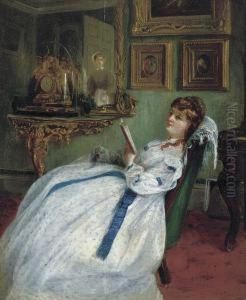William Smallfield Paintings
William Smallfield was a British painter born in 1807, known for his contributions to the Victorian art scene. Not as widely recognized as some of his contemporaries, Smallfield nonetheless made his mark primarily through portraiture and genre painting. His style was characterized by detailed and delicate brushwork, reflecting the Victorian taste for realism and moral narrative.
Smallfield's education and growth as an artist started with his apprenticeship under a heraldic painter. This early experience with detailed heraldic designs likely influenced his meticulous approach to his later works. He continued his studies at the Royal Academy Schools, which was a common training ground for artists aspiring to gain recognition and improve their craft in the competitive Victorian art world. Throughout his career, Smallfield exhibited at the Royal Academy and the British Institution, which were central institutions in the London art scene.
Despite his talents, Smallfield did not achieve the same level of fame as some of his peers. His works often depicted intimate domestic scenes and portraits that captured the nuances of Victorian society and the individuals within it. His paintings, though not groundbreaking in their innovation, provide a valuable glimpse into the social mores and fashions of the period. William Smallfield passed away in 1881, leaving behind a body of work that continues to be appreciated by art historians and collectors interested in the Victorian era.
